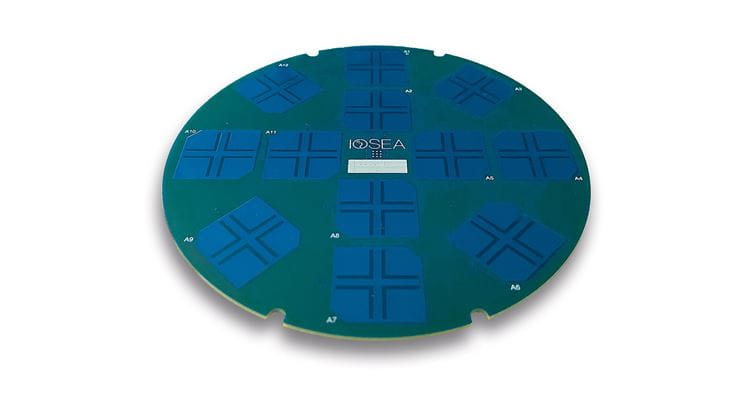Beacons
Use Bluetooth to make environments more informative, engaging and safer

Nordic Semiconductor today announces that IOSEA, a California-based technology company specializing in indoor direction finding solutions, has selected Nordic’s nRF52833 Bluetooth® Low Energy (Bluetooth LE)/Bluetooth 5.2 advanced multiprotocol System-on-Chip (SoC). The SoC will be used with the ‘SEAgnal™ AoA/AoD Switched Antenna Array’ (also known as ‘Plethora Gen 3’) hardware solution and the ‘SEAgnal™ AoA/AoD 1.0’ proprietary software solution.
IOSEA's frequency- and protocol-agnostic SEAgnal technology consists of proprietary software, hardware and antennas that enable RF-based location finding for electronic devices. The SEAgnal solutions are designed to enable real-time location services (RTLS) in third-party devices and applications across a wide array of markets.
The Plethora Gen 3 hardware, which integrates the Nordic nRF52833 SoC and the SEAgnal AoA/AoD 1.0 software, can be embedded into a third-party wearable device for proximity monitoring solutions including Covid-19 social distancing applications. IOSEA’s SEAgnal provides Angle-of-Arrival (AoA)/Angle-of-Departure (AoD) solutions with an angular accuracy of 2 degrees resulting in 10cm position accuracy. The technology uses advanced signal processing methods to mitigate the effects of multipath fading, and signal prefiltering to minimize signal processing algorithm errors and enable low bandwidth data transfer.

The nRF52833 SoC is used to control IOSEA's switched antenna array, sample Bluetooth LE packets and extract the in phase and quadrature phase information (“IQ” signal information) necessary for the AoA/AoD software’s calculations. Using the Nordic SoC-enabled Bluetooth LE connectivity, the proximity data can also be wirelessly transmitted to a Bluetooth 4.0 (and later) smartphone, from where the iOS-compatible ‘IOSEA’ app can be used to monitor and manage angular and location information of wireless tags and beacons discovered by the IOSEA-enabled direction-finding devices.
The nRF52833 SoC’s Bluetooth 5.2 radio is capable of all Direction Finding features enabling positioning applications that not only rely on Received Signal Strength Indication (RSSI) but also signal direction. Its generous memory allocation (512kB Flash and 128 kB RAM) supports both receiver and transmitter roles for AoA and AoD applications. The nRF52833 SoC’s radio architecture with on-chip PA provides -96dBm RX sensitivity (at 1Mbps in Bluetooth LE mode)—a key supporting feature behind the SEAgnal solution’s direction finding precision—as well as a maximum output power of 8dBm, for a total link budget of 104dB.
IOSEA licenses its SEAgnal technology to chip manufacturers, wireless service providers, device makers, and other partners to make location finding affordable, ubiquitous, and convenient for end-users, according to the company. IOSEA's advanced signal processing algorithms make it possible to implement practical location-finding solutions in challenging RF environments through SEAgnal-enabled devices that can run the proprietary software either on chip, at the edge, or in the Cloud.
When the SEAgnal hardware solution is working in AoD mode, the locator can be powered by a battery. The tag device that is being tracked by IOSEA’s locator typically uses coin cell batteries and is configured to maximize power efficiency and extend battery life, thanks in part to the ultra low power characteristics of the Nordic SoC.
Nordic’s nRF52833 SoC provides Bluetooth 5.2 support including 2x on-air raw data bandwidth (2Mbps); 4x range; 8x broadcasting ability with advertising extensions that increase the advertising packet payload size to 251 bytes, and an improved Channel Selection Algorithm (CSA #2) compared with Bluetooth 4.2.
The nRF52833 advanced multiprotocol SoC combines a 64MHz, 32-bit Arm® Cortex® M4 processor with floating point unit (FPU), with a 2.4GHz multiprotocol radio (supporting Bluetooth 5.2, Bluetooth mesh, Direction Finding, 2Mbps throughput, and Long Range plus Thread, Zigbee, IEEE 802.15.4, and proprietary 2.4GHz RF protocol software). In addition to support for Thread, Zigbee, and Bluetooth LE from the nRF Connect SDK (Software Development Kit), it is also supported by the S113, S122, or S140 SoftDevices, Nordic’s Bluetooth RF protocol stacks.
“IOSEA technology enables location services that are scalable, efficient, and precise,” says Pål Kastnes, a Technical Marketing Manager with Nordic Semiconductor. “Solutions like IOSEA’s SEAgnal AoA/AoD proprietary hardware/software solution rely on Direction Finding, a powerful introduction to the Bluetooth LE protocol that will extend its use to widespread applications such as asset tracking, and indoor navigation.”
“Bluetooth LE is very attractive for RTLS applications as it requires only a fraction of the energy of alternative wireless protocols,” says Evangelos Kornaros, CEO of IOSEA. “A Bluetooth LE-powered tag for asset tracking and RTLS can last from months to years without replacing its battery.
“The most important feature of Nordic’s nRF52833 SoC that led IOSEA to use this particular chip is its radio's high sensitivity allowing higher direction-finding accuracy at longer distances,” says Kornaros. “Nordic serves as a good partner due to the company’s invaluable support for its products, knowledgeable application engineers, and a responsive culture.”
Use Bluetooth to make environments more informative, engaging and safer